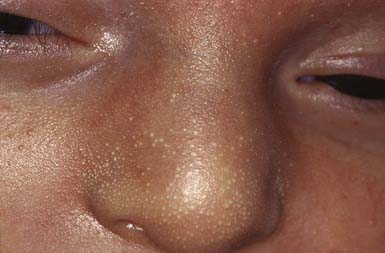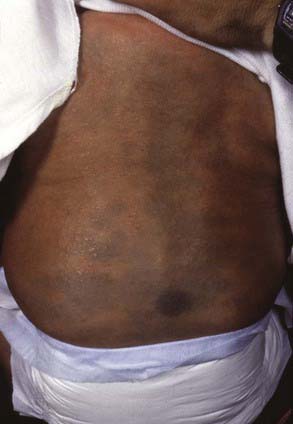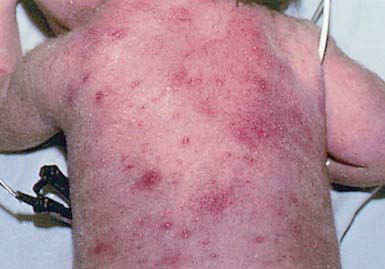Chapter 639 Diseases of the Neonate
Sebaceous Hyperplasia
Minute, profuse, yellow-white papules are frequently found on the forehead, nose, upper lip, and cheeks of a term infant; they represent hyperplastic sebaceous glands (Fig. 639-1). These tiny papules diminish gradually in size and disappear entirely within the first few weeks of life.
Salmon Patch (Nevus Simplex)
Salmon patches are small, pale pink, ill-defined, vascular macules that occur most commonly on the glabella, eyelids, upper lip, and nuchal area of 30-40% of normal newborn infants. These lesions, which represent localized vascular ectasia, persist for several months and may become more visible during crying or changes in environmental temperature. Most lesions on the face eventually fade and disappear completely, although lesions occupying the entire central forehead often do not. Those on the posterior neck and occipital areas usually persist. The facial lesion should not be confused with a port-wine stain, which is a permanent lesion. The salmon patch is usually symmetric, with lesions on both eyelids or on both sides of midline. Port-wine stains are often larger and unilateral, and they usually end along the midline (Chapter 642).
Mongolian Spots
Mongolian spots, which are blue or slate-gray macular lesions, have variably defined margins; they occur most commonly in the presacral area but may be found over the posterior thighs, legs, back, and shoulders (Fig. 639-2). They may be solitary or numerous and often involve large areas. More than 80% of black, Asian, and East Indian infants have these lesions, whereas the incidence in white infants is <10%. The peculiar hue of these macules is due to the dermal location of melanin-containing melanocytes (mid-dermal melanocytosis) that are presumably arrested in their migration from neural crest to epidermis. Mongolian spots usually fade during the first few years of life as a result of darkening of the overlying skin. Malignant degeneration does not occur. The characteristic appearance and congenital onset distinguish these spots from the bruises of child abuse.
Erythema Toxicum
A benign, self-limited, evanescent eruption, erythema toxicum occurs in ≈ 50% of full-term infants; preterm infants are affected less commonly. The lesions are firm, yellow-white, 1- to 2-mm papules or pustules with a surrounding erythematous flare (Fig. 639-3). At times, splotchy erythema is the only manifestation. Lesions may be sparse or numerous and either clustered in several sites or widely dispersed over much of the body surface. The palms and soles are usually spared. Peak incidence occurs on the 2nd day of life, but new lesions may erupt during the 1st few days as the rash waxes and wanes. Onset may occasionally be delayed for a few days to weeks in premature infants. The pustules form below the stratum corneum or deeper in the epidermis and represent collections of eosinophils that also accumulate around the upper portion of the pilosebaceous follicle. The eosinophils can be demonstrated in Wright-stained smears of the intralesional contents. Cultures are sterile.
Transient Neonatal Pustular Melanosis
Pustular melanosis, which is more common among black than among white infants, is a transient, benign, self-limited dermatosis of unknown cause that is characterized by 3 types of lesions: (1) evanescent superficial pustules, (2) ruptured pustules with a collarette of fine scale, at times with a central hyperpigmented macule, and (3) hyperpigmented macules (Fig. 639-4). Lesions are present at birth, and 1 or all types of lesions may be found in a profuse or sparse distribution. Pustules represent the early phase of the disorder, and macules, the late phase. The pustular phase rarely lasts more than 2-3 days; hyperpigmented macules may persist for as long as 3 mo. Sites of predilection are the anterior neck, forehead, and lower back, although the scalp, trunk, limbs, palms, and soles may be affected.








